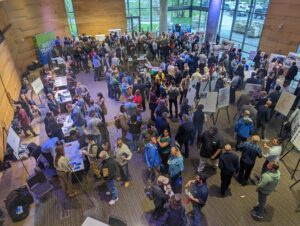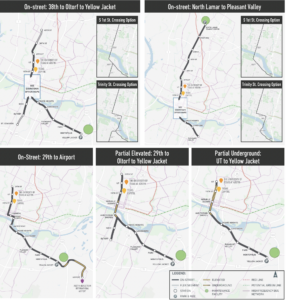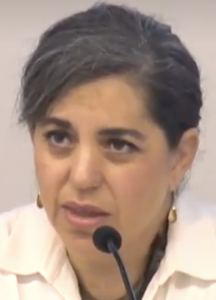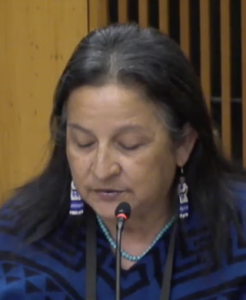Two factors have sparked renewed debate around the cost of Project Connect, the light rail and commuter bus project approved by Austin voters in 2020.
The first is a draft law in the legislature, HB 3899 by former City Council Member Ellen Troxclair, who is now a state representative, to restrict the bonding authority of the Austin Transit Partnership (ATP), the local government corporation implementing the project. Though the bill has made little headway in the legislature—it hasn’t even had a hearing in either chamber—it received plentiful coverage in the local press.
The second factor is a decision by Austin Transit Partnership itself to scale back the scope of the project—a decision driven by cost considerations.
ATP unveiled its plans for the reduced project scope at an open house at the Austin Public Library March 21st (virtual version available here), showcasing five potential routes, none of which would include the previously planned downtown subway stations at Republic Square and the Convention Center.

Only one of the proposed options includes any downtown tunnel, and that option would significantly truncate the Orange Line, ending it at The Drag rather than at the North Lamar Transit Center off US-183 as originally pitched to voters in November 2020.
The options are presented as a single rail line—not two connected lines as presented in earlier system maps. Three of the options eliminate entirely rail service along South Congress Avenue. Under the original plans, the Orange Line would have run down South Congress Avenue to Stassney Lane.
ATP cited “cost increases” as the reason for scrapping the second line, including inflation, increased construction and real estate costs, and “rapid changes in market conditions”—likely a reference to the higher borrowing rates in the municipal bond market.

Additionally, ATP said it had been unable to find a site for a maintenance facility along the Orange Line, citing “a substantial number of business displacements, major utility relocations, and relocation of the Bergstrom Spur trail” that would have been required.
Each plan calls for the addition of about 7 to 10 miles of new light rail compared to 28 miles in the original vision. Several of the options don’t connect with the Red Line, Austin’s only existing commuter train.
Gone too is the vision of seamless travel between air and rail. While the original Project Connect plan called for a rail platform that travelers could step onto directly from the airport terminal, only one of the five options now connects directly with ABIA. CapMetro released sleek concept renderings of a prospective light rail platform at the Austin airport shortly before the November 2020 election.
The four new design options that eliminate the airport station instead place a station either at Yellow Jacket Lane, about two miles northeast of the airport, or at the intersection of Pleasant Valley Road and East Riverside Drive, about six miles away.
Cost estimates

These changes follow the departure of Project Connect’s original leader Randy Clarke, who took a job last summer as head of the Washington Metropolitan Area Transit Authority. Clarke was an outspoken champion of public transit who favored an ambitious vision for Project Connect even as cost estimates soared.

Clarke rankled feathers in April 2022 when ATP updated cost estimates for the project’s light rail components from $5.8 billion to $10.3 billion. The agency’s board announced Clarke’s departure the following month, after which it tapped APT’s chief financial officer Greg Canally as interim director and tasked him with scaling back the vision.
Since then, ATP worked to update the light rail plans to present options with an eye toward “staying within budget,” Canally told media this month in a statement.
The new options each are estimated to cost about $3.5 billion plus a 40 percent cost contingency—somewhat less than the original $5.8 billion cost estimate for the rail component of Project Connect.
Though Canally has no experience working on a major transit infrastructure project, the ATP board appreciated his budget bona fides. They voted unanimously to promoted him from interim to permanent executive director at their meeting March 1st.

In remarks before the vote, Board Chair Veronica Castro de Barrera cited Canally’s good performance as interim director “as well as his long career in city government.” She also cited the organization’s need for “stability and continued momentum.”
Before joining ATP, Canally had been the interim finance chief and deputy chief financial officer at the City of Austin, where he was an architect of the Project Connect funding mechanism approved by voters in November 2020.
How much can ATP borrow?
That financing mechanism is the target of Troxclair’s bill in the legislature. ATP receives a fifth of the City of Austin’s property tax dollars, but it isn’t subject to the same legal restrictions as municipalities regarding issuance of bond debt.
Under current law, local government corporations created by municipalities can issue bonds without voter approval. Troxclair’s bill would require local government corporations to get voter approval before issuing bonds to fund infrastructure costs—just as local governments have to do when they want to impose a property tax to secure the issuance and repayment of a bond.

Troxclair’s bill effectively would require voters to approve Project Connect a second time. In the November 2020 election, 57.92 percent of voters approved Proposition A.
The ballot measure boosted the City of Austin’s property tax rate by more than 20 percent and dedicated a portion worth 8.75 cents per $100 valuation toward Project Connect and the Austin Transit Partnership.
Unlike most infrastructure referenda in Texas, Proposition A was a tax rate election, not a bond election. That’s a type of election called when a governing body of a tax entity adopts a tax rate exceeding a 3.5 percent new revenue cap.
Such a tax increase is permanent until changed back by the governing body, and therefore differs from a typical infrastructure bond election in which voters approve a tax that goes away once the interest and principal on the bonds are repaid.
The arrangement gives ATP significant discretion as to how much it can spend on Project Connect. Troxclair calls it “a blank check signed by the taxpayers.”
Although Austin voters were told that Project Connect would cost $7.1 billion ($5.8 billion for rail and $1.3 billion for other project components), this amount isn’t legally binding; exceeding the budget presents a political constraint for ATP, not a legal one.
This was a feature and not a bug of the original funding mechanism. Project Connect’s promoters in 2020 referred to the $7.1 billion cost as an “initial investment”—not a final total—detailing several expansion options, including potential extensions of the original Project Connect rail network to the north, east, and south.

Former County Commissioner Gerald Daugherty is one of a handful of Project Connect opponents backing Troxclair’s efforts to get HB 3899 through the legislature. Like Troxclair, he contends the city unfairly sidestepped the voter-approval requirements for issuing debt and “bamboozled” voters by misleading them about the costs and scope of the project.
Daugherty was a leader in the ROAD (Reclaim Our Allocated Dollars) PAC that defeated a $1.9 billion light-rail election in November 2000. He argued on a recent episode of the Austin City Councilman podcast that the voters who approved the tax increase in 2020 hadn’t done so thinking it would be permanent and irreversible.
His concern is that the bond issuance ties the hands of future city councils. Although a council typically could reduce a tax rate approved by voters in a prior year, the Proposition A tax rate would be tied to billions of bond debt. It couldn’t be eliminated or reduced without potentially triggering a bond default that could affect the city’s own credit rating.
Both Troxclair and Daugherty are Republicans. Austin’s mayor, Kirk Watson, a Democrat and former state senator, told KUT in March that Troxclair’s bill would “deny the result of an election and overturn the voice of the people of Austin.”
Watson also outlined how he might seek to convince the bill’s senate sponsor, his former Republican colleague Paul Bettencourt, to kill the bill.
Bus infrastructure delayed, could run over-budget
The bus component of Project Connect is progressing more rapidly than the rail component but also faces lengthy delays.
ATP is making grants to CapMetro, the operator of Austin’s mass transit system, to build the bus infrastructure necessary for new commuter lines and neighborhood circulators, including stations for riders and the operating yards for the vehicles.
ATP’s budget last year included $42 million for four CapMetro MetroRapid projects, including $11 million for the new Expo Center route, $14 million for the new Pleasant Valley route, $11 million for the new Gold Line, and $6 million for an extension of the existing 803 service route.
A budget amendment in July increased funding for the Expo and Pleasant Valley routes by $9.2 million (this change wasn’t the result of a cost overrun but had to do with federal small-grants compliance requirements to fully appropriate multi-year funds).
Using ATP funds, CapMetro also plans to acquire a new electric fleet of buses, replacing the diesel-powered vehicles currently in use.
“Construction continues on our Pleasant Valley and Expo Center rapid lines. These two lines were promised to the community with an all-electric fleet, with service anticipated to begin in 2025,” said Molly King, CapMetro’s Executive Vice President of Project Connect Integration, at a March 1st board meeting of ATP.

That start date is about two years later than previously promised. Dottie Watkins, CapMetro’s CEO, told KXAN in February that the delay was caused in part by a lack of charging infrastructure along the routes for the all-electric fleet.
“We hadn’t originally planned for that,” she said, also citing supply chain issues associated with the fleet electrification. Seven of 37 buses have been delivered so far, according to King’s presentation to the board. CapMetro completed ten platforms along the routes, with 57 still in design or permitting.

ATP Board Member Tony Elkins said he had been “blindsided” by news of the delays after CapMetro told the board in November that construction was progressing well.
Watkins acknowledged that “some of our board members were surprised to learn that these changes were afoot.” Elkins said, “There is a real cost to the community of not having that service on board for another 18 months. We have to acknowledge that cost—basically the societal cost of delayed infrastructure.”
He also raised concerns about potential cost overruns: “I understand there will be potential cost overruns. It’s my understanding that under the ILA (interlocal agreement) between ATP and CapMetro any cost overruns associated with the MetroRapid would not be absorbed by ATP.”
Watkins replied, “That is not my understanding. The interlocal agreement itself will need to be amended if there are additional costs that need to be covered. But we have not yet gotten to the point that we need to bring an amended inter-local agreement. It would need to be approved by both the ATP board and the CapMetro board if we determine that changes are needed.”
So far this year ATP hasn’t appropriated any additional funding for the bus projects because the earlier capital appropriations remain only partly spent.
Red Line station nearing completion
CapMetro also is overseeing construction of Red Line components of the system plan, the first rail components undertaken since Project Connect began. The Red Line has been running since 2010 but Project Connect calls for certain improvements.
In January, CapMetro completed a double-tracking project to offer more frequent service to Leander, the Red Line’s northern terminal stop.

Builders have also almost completed a new station at McKalla place, where the Q2 soccer stadium was built in 2021. That station is a partnership among CapMetro, the City of Austin, Austin FC, and Austin Transit Partnership.
It cost $59 million to build, of which ATP is paying $13.5 million. King said construction at the McKalla Station is “currently on-time and on-budget and we are anticipated to be ready for the Austin FC 2024 season.”
Transit funds for housing
Proposition A also authorized ATP “to finance the transit-supportive anti-displacement strategies related to Project Connect.” In accordance with that commitment, ATP has an arrangement to pay the city $300 million for anti-displacement initiatives over a 13-year period.
However, the city has been slow to disburse that money, incurring no spending in the first year of the program even as displacement pressures ramped up as a result of speculative real estate investment along prospective transit corridors. The Project Connect tax itself also has an impact on affordability.
Although some anti-displacement funds were disbursed last year, the programming is just getting underway. The City’s Housing and Planning Department is managing these programs, guided by a community advisory committee. Last year the committee allocated $23 million for land acquisition, $21 million for affordable housing initiatives, and $20 million for “community-initiated solutions,” meaning non-profits.
The city announced grant award to 14 nonprofits last September following a grant solicitation. Those organizations proposed to carry out a variety of programs including household assistance, home maintenance, and tenant rights education.

Critics have questioned how impactful these programs could be. At a meeting of the City’s Community Development Commission March 8, 2022, Montopolis Neighborhood Association representative Susana Almanza said, “We worry that ‘business as usual’ will lead the city to needlessly squander the $300 million in anti-displacement funds on unnecessary consultants, administrative overhead, and other initiatives while shirking (investments in) land for affordable housing and related community-development efforts.”

The committee plans to allocate an additional $23 million for land acquisition in 2023 and $10 million for affordable housing development, according to a February 9th memo by committee chair Awais Azhar. “These recommendations reflect the need for land acquisition, preservation of existing market affordable housing, and the creation of income-restricted affordable housing at the earlier stages of the Project Connect programs,” he wrote.
Budget
Although Project Connect is overbudget, it is also collecting more revenue than anticipated. A surge in property values boosted ATP since its creation in 2021. In fiscal 2022 it collected $157.3 million from property taxes, compared to a budget of $154.8 million. In 2021 it collected $149.3 million compared to a budget of $144.7 million. This year ATP expects to collect $159 million in Prop A property taxes.
Those revisions stem partly from new properties added to the tax roll. ATP’s other revenue sources include a $20 million contribution from CapMetro’s sales tax receipts and $10 million from that agency’s capital expansion fund, plus investment interest income of $3.9 million, for total revenue of $192.9 million, according to the budget.
With that amount of revenue, it would take ATP about 26 years to pay for a $5 billion project, or more than 50 years if the project ends up costing more than $10 billion as projected by the agency last year before altering the project scope.
However, that back-of-the-envelope math doesn’t account for potential federal grants and loans, nor for the interest expenses associated with issuing bonds.
 Trust indicators: Bulldog reporter Daniel Van Oudenaren is a journalist with 13 years experience in local, state, and international reporting.
Trust indicators: Bulldog reporter Daniel Van Oudenaren is a journalist with 13 years experience in local, state, and international reporting.








Ellen and Gerald should return to their gopher holes where they belong and they can take Mr. Canaly with them…so typical, put someone in charge of a transportation project who has zero transportation experience…but hey, long tenure at the Ciity is all the experience one needs to continue to implement one bad decision after another.
I think Daniel did a very nice job of laying out the Project Connect project. This is a VERY complex project that unfortunately is being controlled by engineers and community communication folks…both being paid large sums of money to keep this charade going…as a 14 year elected official and a resident of Austin/Travis County I have NEVER witnessed a bigger scam than Project Connect…this whole program is out of control and is being paid for by every property owner (both residential and commercial) with city of Austin property taxes…that is a 20% tax increase EVERY year from now on if this project is allowed to continue! City of Austin taxpayers have been taken for a ride! Gerald Daugherty
stop talking and planning and start building, getting tired of all the he said she said blame games find someone who knows what they are doing and build it.